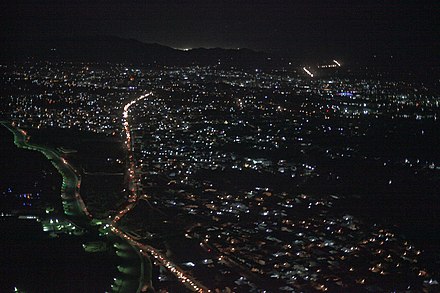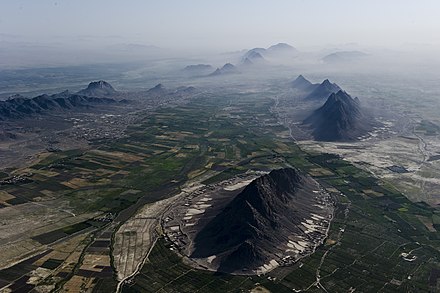Kandahar - city in Kandahar Province, Afghanistan
Country under Taliban control. Travel to or within Kandahar is strongly discouraged at this time. See the warning on the Afghanistan article for more information.
Kandahar (Pashto: کندهار) is the capital of Kandahar province, and the largest city in Southern Afghanistan. Kandahar is also the second largest city in Afghanistan, and was the first capital of the modern state of Afghanistan in the 18th century.
Understand
 Kandahār or Qandahār (Pashto: کندهار; Persian: قندهار) is one of the largest of Afghanistan's thirty-four provinces and is located in the southern region of the country. The province connects with Pakistan's Balochistan province through the Spin Boldak-Chaman border crossing. The city of Kandahar was the capital of Afghanistan prior to 1776. It is an economic and political hub of Afghanistan and has always played a major role in the nation's history.
Kandahār or Qandahār (Pashto: کندهار; Persian: قندهار) is one of the largest of Afghanistan's thirty-four provinces and is located in the southern region of the country. The province connects with Pakistan's Balochistan province through the Spin Boldak-Chaman border crossing. The city of Kandahar was the capital of Afghanistan prior to 1776. It is an economic and political hub of Afghanistan and has always played a major role in the nation's history.

 Kandahar's residents are Pashtuns (Pashto: پښتون Paṣ̌tun, Pax̌tun) of various tribes, with small communities of Tajiks, Turkmens, Uzbeks, Hazaras, Baloch and others scattered in and around the city. They have lived in harmony each other throughout history. The people of Kandahar enjoy humor and laughter, and they often talk about sports, history and geopolitics. Many influential Afghan rulers, such as Mirwais Khan Hotak, Ahmad Shah Durrani, Abdur Rahman Khan, Amanullah Khan, and Hamid Karzai, originate from Kandahar. The city has also produced a number of prominent Afghan poets, singers, scholars, intellectuals, academics and businessmen.
Kandahar's residents are Pashtuns (Pashto: پښتون Paṣ̌tun, Pax̌tun) of various tribes, with small communities of Tajiks, Turkmens, Uzbeks, Hazaras, Baloch and others scattered in and around the city. They have lived in harmony each other throughout history. The people of Kandahar enjoy humor and laughter, and they often talk about sports, history and geopolitics. Many influential Afghan rulers, such as Mirwais Khan Hotak, Ahmad Shah Durrani, Abdur Rahman Khan, Amanullah Khan, and Hamid Karzai, originate from Kandahar. The city has also produced a number of prominent Afghan poets, singers, scholars, intellectuals, academics and businessmen.
Kandahār is located at about 1,005 m (3,297 feet) above sea level. The Arghandab and Tarnak rivers run along the city. These major rivers turn into numerous smaller rivers, lakes, ponds, creeks, streams and canals in and around the city. They create lush green gardens and enhance the natural beauty of the city.
Kandahar province has a population of around 2 million people, with over one million residing in its capital city. The majority of Kandahār people are engaged in agriculture, import and export, real estate, small businesses, and government services. Kandahār is a major exporting center of fresh and dried fruits. It has a small but growing industrial park.
Like other Afghan cities, Kandahār is slowly developing. It has a very large international airport. The city is linked by main roads to nearby cities such as Tareen Kot in the north, Ghazni in the northeast, Quetta in Pakistan in the south, and Lashkar Gah in the west.
Get in
By plane
- Kandahar International Airport (IATA: KDH), 31.507222°, 65.850278°. now has flights on Ariana Afghan Airlines & Kam Air between Kandahar, Dubai every Wednesday Ariana & Monday Kam Air; as well as three domestic flights per week between Kabul and Kandahar and one Domestic flight from Kandahar-Herat-Kandahar every Tuesday by KamAir. Flights are also available by the UN & ICRC but are only open to UN staff and other approved organisations.
By car
The A01 highway links Kandahar with Kabul. It is one of the busiest in Afghanistan. The highways in Afghanistan are sometimes dangerous due to militant activities but the militants do not necessarily target tourists. Total drive between Kandahar and Kabul is approximately 6 hours. The highway from Kandahar to Herat is sometimes dangerous, especially where it passes in Helmand and Farah provinces. Highway A75 runs southeast towards Spin Boldak, which is the last town in Afghanistan before the start of a Pakistani highway.
By bus
There is a large national bus station called "Kabul Adda" (meaning Kabul Junction) and is located a block north of Durahi Circle in the affluent Aino Mina section of the city. The buses take passengers to Kabul, Lashkar Gah, Zaranj, Herat, and Spin Boldak. Smaller vehicles are also available at this station to take passengers to other destinations within the province and beyond.
Get around
To get around the city visitors can use taxis or rent a vehicle, which usually comes with a reliable driver but special arrangements can be made to exclude the driver. The basic requirement for such special rental is insurance for the vehicle.
See
 There are a number of historical sites to visit in and around Kandahar.
There are a number of historical sites to visit in and around Kandahar.
- Mosque of the Cloak of the Prophet Mohammad, 31.6196°, 65.708°. One of the holiest sites in Afghanistan, contains what is said to be a cloak/robe worn by Prophet Mohammad during his famous night journey. The cloak is locked away inside and has not been taken out since 1996. 2019-04-25
- Chil Zena, 31.615278°, 65.663611°. Historical site located in the Sarpuza neighborhood. Climbing the 40 steps is dangerous. As such, children and elders should not climb them. 2020-01-26
- Kandahar Museum, 31.620362°, 65.711794°. Contains the paintings of Ghiyassuddin, regarded as one of the most important Afghan painters of all time. 2020-01-26
- Tomb of Ahmad Shah Durrani, 31.619605°, 65.707223°. Resting place of Ahmad Shah Durrani, the founder of the state of Afghanistan. 2020-01-26
- Shrine of Hassan Abdal (Baba Saab). Hassan Abdal, also known as Baba Wali, a poor man of unknown origin performed miracles for people, is buried at this site. Nobody has been able to determine who he was or where he came from. When he died, the people of Kandahar decided to bury him at this site. 2019-04-25
- Shrine of Mirwais Khan Hotak. Located east of the city near Etehad Mosque before reaching Bagh-e Pool (Bridge Park). 2020-01-26
- Dahla Dam. 2020-01-26
Do
There are many outdoor places to swim in Kandahar. There are no alligators in Kandahar but various types of snakes, scorpions and spiders do exist. The people of Kandahar traditionally enjoy family picnic trips. This sometimes involves driving to other districts of the province, usually where their farms are located.
- Kandahar International Cricket Stadium, inaugurated in 2017, in Aino Mina.
- Kandahar Football Stadium, located in the Shahr-e Naw neighborhood next to the Ghazi family park.
Buy
All business transactions in Kandahar are done by using cash and only in the nation's currency, the Afghani.
- Afghanistan International Bank (AIB), Afghan United Bank, Afghan Milli-e-Bank, Azizi Bank, and New Kabul Bank all have branches in the city with cash machines. Western Union service is available in various locations in the city.
- Farhad Super Market, +93 71 111 1790. 2022-07-02
- Kandahar Super Market, 11th Street, Aino Mina (next to First Fountain), +93 70 065 8080. 2022-07-02
Eat
There are a growing number of restaurants. Most of them serve Afghan cuisine. The popular items include roasted chicken, mutton, lamb, and beef, along with rice dishes, cooked vegetables, and plenty of fresh fruits. Fast food places that serve pizzas, burgers and other sandwiches are also growing. The best street food in Kandahar is fried fish and samosas along with several styles of freshly-baked local bread.
Budget
- Mano Salwa Restaurant, in Share New neighborhood.
Mid-range
- Afghan Dubai BBQ, in Aino Mina, +93 70 400 4458.
- Anar Restaurant, Shar-e Nau (next to Afghan Turk High School), +93 70 079 7400. 2022-07-02
- Delicious Pizza, middle of the city (very near Omar Mosque), +93 70 036 9800. 2022-07-02
- Italian Pizza, Aino Mina (next to female park), +93 70 035 2027. 2022-07-02
- Mumtaz Restaurant. Indian, Chinese and Afghan cuisine, in a large hotel.
- Pizza Hot, Aino Mina (next to Children Park), +93 70 001 4149. 2022-07-02
- Pizza King, Aino Mina next to Children Park, +93 70 079 1100. 2022-07-02
- Pizza Point, Aino Mina, +93 70 300 0747. 2022-07-02
- Royal Restaurant, in Aino Mina, +93 070405854.
- Shabistan Restaurant, in Aino Mina, +93 70 035 8725.
- Tasty Pizza, Shar-e Nau (next to Kandahar Football Stadium), +93 70 027 2723. 2022-07-02
- Turkish Taste, in Aino Mina.
Splurge
- Lamar Restaurant, Shar-e-Naw, +93 700363636. 5-star rated restaurant with Indian, Continental and Afghan cuisine. 2022-07-02
Drink
Selling alcohol is illegal in Afghanistan, but this rule is not strictly enforced like in Saudi Arabia. Smoking hashish (marijuana) is common in Afghanistan, and it does not lead to an arrest.
Sleep
Budget
- Afghania Restaurant And Guesthouse (Armani Pashtun), First Fountain in Aino Mina (across from Afghan United Bank), +93 70 032 0342. 2022-07-02
- Armani Pashtun Bed And Breakfast (Armani Pashtun), +93 705601977, yawafamily1@gmail.com. Check-in: 12:00, check-out: 11:00. B&B accommodation, transporter available with affordable price From US$10 per night 2017-07-20
Mid-range
- Asman Hotel, Shar-e Nau Road (Near Dand Chowk). 2022-07-02
- Afghan Continental Guest House, Second Fountain, Aino Mina, +93 70 000 4655. 2022-07-02
- Continental Guest House, Shar-e Nau Road, Herat Darwaza (near Zarghoona Anna Lisa), +93 303001924, +93 70302613. In center of city, has air conditioning and Internet access inside rooms. Food is available from own restaurant. From US$55 per night. 2022-07-02
- Dubai Inn, Aino Mina (next to Fish Fountain), +93 70 606 6000. Food is available from own restaurant. 2022-07-02
- Etemad Hotel and Restaurant, Shafakhana Road, Shar-e Nau, +93 70 734 4710. Food is available from own restaurant. 2022-07-02
- Noor Jahan Hotel, Shar-e Nau (Next to Shahidano Chowk), +93 70 020 3222. Food is available from own restaurant. 2022-07-02
- Mirwais Hotel, Shar-e Nau (Next to Shahidano Chowk), +93 70 030 5806. Food is available from own restaurant. 2022-07-02
- Royal Afghan Hotel, +93 79 000 0541. Food is available from own restaurant. 2022-07-02
Splurge
Connect
4G LTE services, smart phones and smart TVs are available in Kandahar.
Stay safe
Kandahar has been one of the safer cities in southern Afghanistan, especially its Aino Mina section located in the east and closer to the main airport. The most advanced hospital is in Aino Mina, which opened in April 2019. Blending with the locals is a good way to prevent unnecessary attention. Residents of Kandahar are friendly and hospitable, but some of those from other places who are staying in the city may not be. Kandahar residents treat foreign tourists as special diplomats. Many residents of Kandahar also have family and friends who are citizens of countries in Europe, Oceania and North America.
Cope
Consulates
- India
- Iran
- Pakistan
Go next
Kandahar
kandahar.gov.afKandahar District
2nd-order administrative division
Kandahar
Primary administrative division